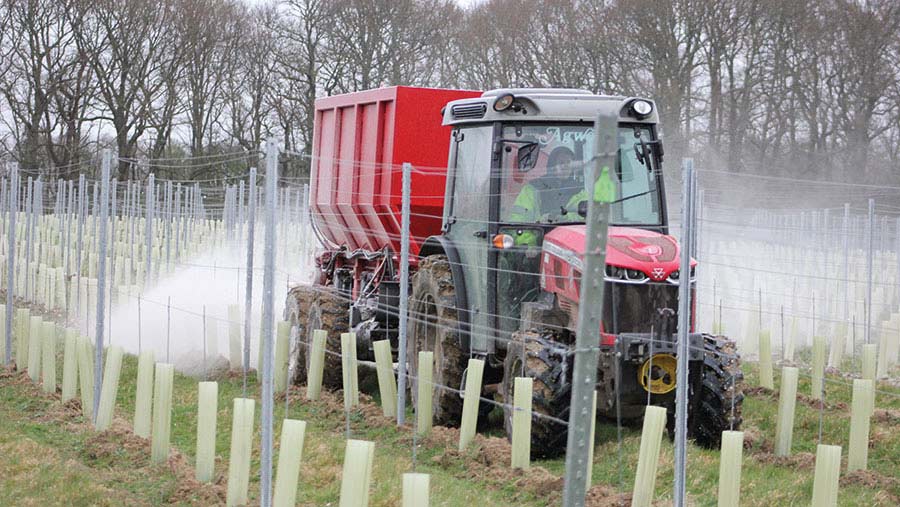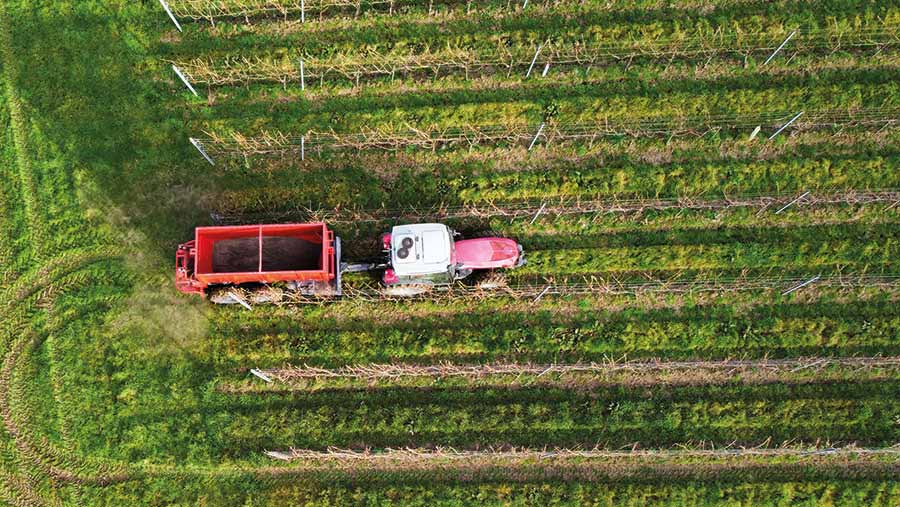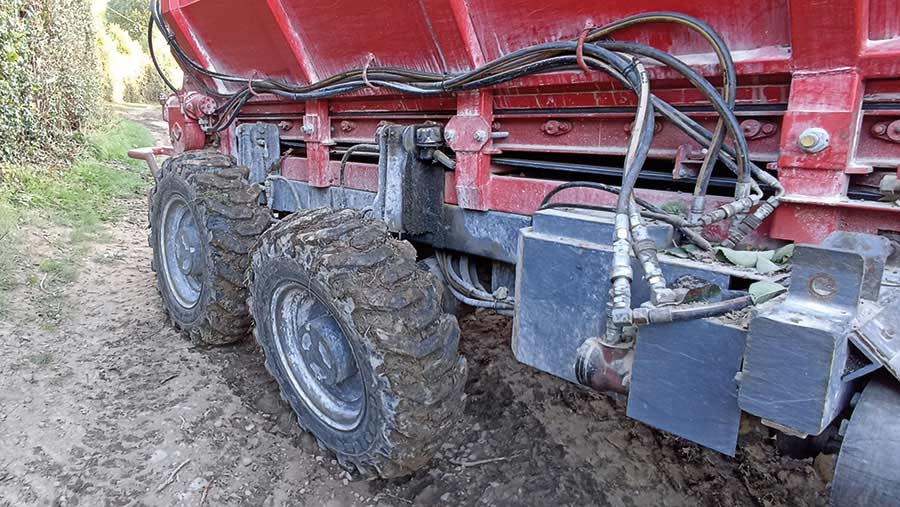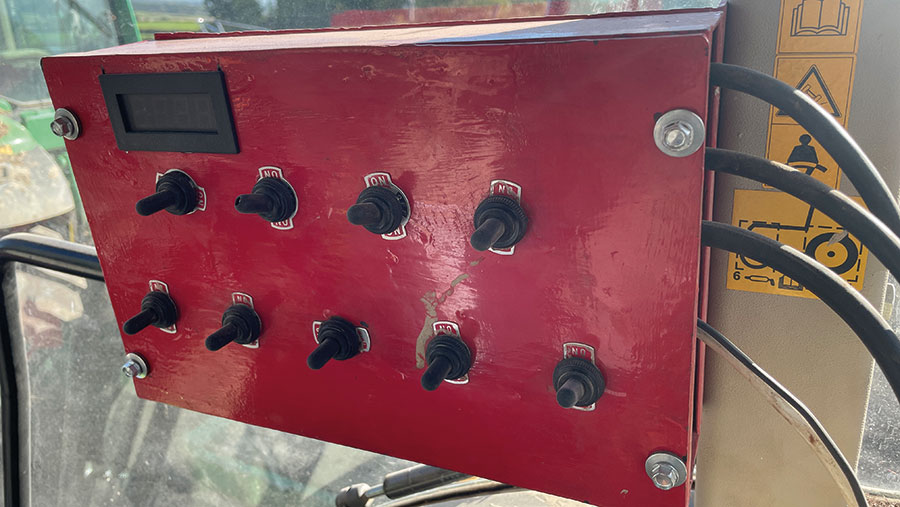Kent contractor develops driven-axle spreader
 © John Bourne and Co
© John Bourne and Co Compost, manure, lime, fertiliser, chicken pellets, fibrophos… you name it, Richard Moon’s home-built spreader can apply it – deposited in strips or chucked out in a 10m wide band.
Based in Sandhurst, Kent, the Moon contracting business, operated by Richard and his father, Charles, started out as a mainstream lime, fertiliser and muckspreading company back in the 1990s.
Today it still runs a Samson Flex 16, an Econ and a couple of Bredals for this conventional work.
See also: Ejector trailers: What’s on offer and how much do they cost?
However, the rapid growth of the UK’s wine sector – according to Wine GB, there has been a 70% increase in the UK area under vines over the past five years – has seen the Moons’ more specialist work gradually dominate.
It now represents more than 60% of the firm’s annual turnover — hence the need for the “new” spreader.

The Moon spreader has a workload that extends from October through to June. Power comes from an 84hp MF 3640S © John Bourne and Co
The build design brief
“Our older, home-built spreader, which we still run, does a good job, but it has its limitations,” says Mr Moon.
“It’s a single-axle machine that only spreads compost and manure and, because of its narrow width and relatively tall sides, it can be unstable when travelling across the sloping ground and banks often found in smaller, more traditional vineyards.
“If it gets a lean on, there is also a real risk of the top of the body knocking the rows of vines and trees.”
So, the design brief was clear for the new spreader.
It had to have two powered axles, two-wheel/four-wheel steering, effective braking, a 5-6t-capacity self-levelling hopper and the ability to spread a broader range of materials.
And it also had to squeeze down a 2m-wide vineyard row.
The aim was to build a machine with improved stability, safety, wet ground performance and manoeuvrability.
“Bottom line was we wanted a more versatile machine capable of extracting itself from the trickier situations we often encounter,” Mr Moon said.
The Moons looked at what was available on the market but couldn’t find anything that ticked all their boxes.
So, in 2019, they decided to build their own. The component budget was about £10,000.
Charles Moon and Sons
- Main contracting enterprises Spreading across arable land, orchards, vineyards and hop gardens; GPS soil sampling
- Materials spread Compost, manure, lime, fertiliser, chicken pellets, fibrophos
- Area covered Predominantly Kent and Sussex but will travel farther
- Machinery fleet
* Tractors: 180hp John Deere 7530 with Quicke Q65 loader, 170hp John Deere 6170 with Quicke Q76 loader, 84hp MF 3640S, 95hp MF 3709S, 45hp MF 135
* General-work spreaders: Samson Flex 16, Econ, and two Bredal spreaders
* Narrow-work spreaders: One home-built, single-axle spreader (compost and manure) and the featured twin-axle spreader (all materials)
Making a start
The first step was to find a pair of axles with drive and steering, which was narrow enough for a vineyard row.
The eventual source was the rear axle off a JCB 520-40 telehandler. One axle was discovered in a breaker’s yard, the other on eBay – at a cost of £1,000 apiece.
The axles’ original JCB wheels and tyres (15/55-17s) are still used for orchard work but, to shrink to the 1.6m overall machine width requirement for vineyard applications, the Moons acquired a set of wheels with 280/80 R18s.
The latter set’s rims had to be modified – centres out and repositioned – to achieve the necessary chassis clearance for levelling and steering.
Modification was also required to the spreader’s two self-levelling rams, which were bought new.
They had to be shortened by 50mm to create sufficient space for the floor chains when the muckspreader body is on board.
As for the steering, another two rams were needed. The eBay axle arrived with its own ram — job done — whereas the other came without. A used item was quickly sourced.
Control of the levelling and steering rams is relatively straightforward via solenoid valves.
The levelling rams are plumbed to give a degree of self-levelling, with a solenoid enabling the operator to make manual tweaks from the cab.
In contrast, there are two solenoids for the steering, so the operator can control all four wheels or just the rear pair, depending on where the second solenoid is set.
Electric was the control method of choice, to minimise the number of cables and pipework.
With axles on, and steering and levelling in place, the 100x150mm box section chassis started to take shape.

The two-/four-wheel steering comes into its own on tight vineyard headlands. General practice is to travel down one avenue, miss two and back up the next. Distance between vine rows is typically 2m © John Bourne and Co
Drive and brakes
This is where the project almost foundered. “We priced up a new hydrostatic drive setup but, at £20,000-£30,000, it was clearly a non-starter,” says Mr Moon.
“A more basic mechanical drive was never an option because of the need for variable travel speed when spreading, so we opted to go with our own hydraulic system. Also, the JCB axles had no braking, which meant starting from scratch there, too.”
Each axle has its own brake drum and hydraulic motor. A prop from the axle hub is connected to the brake drum via chain and shaft.
Another chain heads from the brake drum to a sprocket on the hydraulic motor, with a home-made, actuator-operated dog clutch in between.
The latter prevents the constantly spinning chains from damaging the motor when it is in “neutral” and the spreader is freewheeling.
From the cab, the operator can select between spreader drive modes — “forward”, “neutral” and “reverse” — and vary the axle motor speed via a solenoid-controlled flow valve.
The brakes are a simple and fairly standard agricultural arrangement. The single ram operates the two drums, one drum on each axle.
Engaging the brake stops the chain spinning and the hub from turning.
Moon vineyard/orchard spreader spec
- Dimensions (l/w/h) 5m; 1.9m flotation tyres, 1.6m narrows; 2.5m
- Capacity Up to 6t of lime
- Spreading width 10m band or laid in strip
- Drive system Hydraulic motors, chain and shaft; pto-driven hydraulic pump
- Levelling Two hydraulic rams
- Steering Hydraulic two-wheel or four-wheel steer
- Power requirement About 90hp
- Build price £10,000 excluding labour
Power and control
With all the key hydraulic components crammed in, the final chassis job was to provide them with power.
Here the choice was a pto-powered double hydraulic pump, supplying 30 litres/min for the steering/levelling and 140 litres/min for the spreader’s wheel drive.
A speed-increasing, on-board gearbox allows the MF 3640’s pto to be used on the relatively frugal 540eco setting, and there is also a dedicated, home-built oil tank that holds 120 litres.
As for control, this is via a nine-switch box that occupies the right-hand side of the little Massey’s cab and takes care of all the main chassis functions — wheel drive speed and direction, two-/four-wheel steering, levelling — and some of the spreader body functions, too.

No shortage of control choice – a total of nine switches looks after most of the chassis/spreader functions, while the little display screen (top left) shows floor belt speed when the lime spreader is on board © John Bourne and Co
Spreader bodies
Chassis completed, Mr Moon reckons that knocking up the two demountable spreader bins was the easy bit.
Spreader one comprises a 5t bin, chain-and-slat floor and a couple of hydraulic motors — one for the floor and the other for the permanently installed, front-mounted cross-conveyor.
The conveyor is not demountable, so remains in place and is redundant when spreader two is in situ.
Spreader one handles all the dirty stuff — compost and manure — with the cross-conveyor dropping the material in a narrow strip, to the left or right, along the base of the vines or orchard trees.
Spreader two applies all the other materials such as lime, fertiliser and chicken pellets.
It boasts a similar-capacity bin, but in place of the chains and slats there is a belt floor and rear-mounted spinning discs.
One hydraulic motor powers the floor, two more spin the discs, and all three are piped to run off the one spool.
Both of the bodies’ hydraulic doors are powered by the tractor’s second spool valve.
Verdict
Two years in the making and £10,000 of component cost. So, was it worth all the aggravation and cash?
“Absolutely,” says Mr Moon. “We now have a machine that is more manoeuvrable, safer to use and more versatile.
“We can spread up- and downhill, get ourselves out of tricky situations in greasy conditions, and on sloping ground the self-levelling means we’re less likely to damage the vines or trees.
“The one downside is that the machine is heavier, but the performance advantages more than make up for this.”
Next project? “To build a similar machine for Dad.”
Component costs (approx)
- JCB axles (x2) £2,000
- Hydraulic pumps £600
- Gearbox £300
- Hydraulic motors (x2) £400
- Valves (x5) £1,000
- Chassis steel £500
- Wheels (sets x 2) £1,500
- Machining costs £1,000
- Assorted other items £2,700
- Total £10,000
